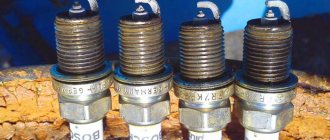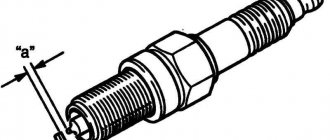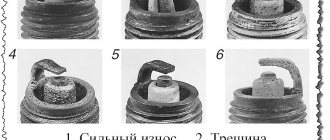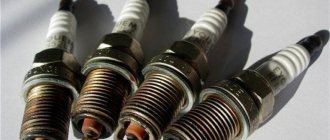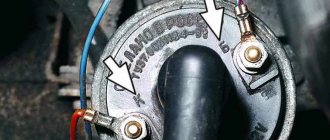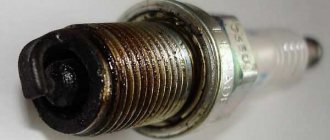Sooner or later, all drivers are faced with the regular problem of replacing spark plugs. And those who are not used to using the services of auto mechanics and prefer to figure it out themselves, very often witness the formation of carbon deposits on spark plugs. Yellow deposits on the spark plug insulator, or brown deposits on spark plugs, are formed for certain reasons, and their nature is quite often different from each other. In this article, we will try to understand them and also explain how to avoid such a fate in the future.
Brown deposits on the spark plug insulator
Causes of soot
The normal service life of spark plugs is 50 thousand km. Once this milestone is reached, they must be replaced. This is a normal result and cannot be avoided. An interesting fact: you can take excellent care of your car, but plaque will still appear. Their normal color is grey. Minor changes are not scary if the electrodes do not have visible damage. If plaque appears on new spark plugs, then you need to look for the reasons.
Causes of soot formation - why does this happen?
Spark plugs in an internal combustion engine perform the function of timely ignition of the fuel-air mixture. With their help, a spark is created, which ignites the fuel. Due to their design features, the lower part of the spark plugs is always located directly in the combustion chamber of the engine, which is why they experience enormous temperature loads, are subject to constantly high pressure and various chemical processes.
Therefore, over time, carbon deposits form in the lower part of the spark plug, on the insulator or electrodes, and various deposits and darkening may also appear. On a working engine with high-quality spark plugs, carbon deposits, as a rule, have a gray tint. It coats them in an even, dry and light layer. This situation is absolutely normal, especially if the spark plugs have already “run” more than 50 thousand kilometers.
If there are problems with the engine and related systems, the color of the spark plugs may change, and an uncharacteristic dry or spotty coating of red, white or black color begins to form on it. If, after unscrewing the spark plugs on the engine of your car, you find such deposits, you should diagnose the engine, check the ignition timing (ignition timing), the set gaps and other possible causes of deposits, which we will discuss in more detail below.
conclusions
Analysis of this problem and the experience of motorists suggest that visual diagnosis of spark plugs covered with soot is an excellent method not to miss the onset of problems with the car’s fuel system. You need to not be lazy and inspect these parts from time to time. In addition, do not forget that protective gear has its own service life, and when plaque appears, this is the first thing to check. If necessary, the spark plugs must be replaced and only then proceed with initial engine diagnostics.
The best prices and conditions for the purchase of new cars
The engine is the heart of any car, and spark plugs are, of course, one of the main indicators of its proper operation. It is because of their malfunction that the engine may not start at all. The most common problem with candles is black soot. If it appears, the driver’s main task will be to identify and eliminate the cause, since this determines the performance of the vehicle.
What color is considered normal?
The performance of the gasoline power unit is indicated by spark plug electrodes painted in a light brown tint, without oil deposits and soot. A similar picture is observed in completely new engines and engines that have undergone a major overhaul.
If the color of the working part differs from the specified one, it is advisable to carry out further diagnostics and identify the cause of the problem. Moreover, the engine itself is not always the culprit. What color options are there for spark electrodes:
- light gray or white;
- black;
- brick or frankly red tint.
In addition to all sorts of colors, the candle skirt is covered with various deposits - soot, brown soot, or may simply look wet. These phenomena are also considered signs of various malfunctions. It is proposed to consider each situation in more detail.
Types of carbon deposits on spark plugs
So, the car has driven a certain distance (15-20 km), and if, after unscrewing the spark plugs, it is discovered that the electrodes are light brown, “brick” (the color of red brick), then everything is in order with the engine - the systems are functioning normally, the processes in the chambers combustion is not disturbed.
But this shade does not always happen. Often, after unscrewing, it is discovered that the candles have the following color:
- Black;
- White;
- Red.
In addition to carbon deposits of different colors, traces can be found on the electrodes:
- Gasoline;
- Oils;
- Ash deposits;
- Erosion.
And every discrepancy with the norm has its own reasons. Therefore, a simple inspection of the spark plugs can help in identifying malfunctions or malfunctions of systems and mechanisms, and at an early stage and eliminating them before serious problems arise.
Reasons for the formation of plaque and soot on candles
Black soot and the reasons for its appearance
As already noted, black soot is a consequence of feeding an enriched mixture. But if before the power plant reaches the optimal temperature regime, this mixture ratio is normal, then the detection of velvety black deposits on the electrodes after a long trip indicates the emergence of problems in the operation of the power system. This can happen due to:
- incorrect carburetor adjustment;
- failure in the injection engine ECU;
- sensor malfunctions (as a result of which the control unit begins to operate in emergency mode);
- severely clogged air filter.
A table showing the types of carbon deposits on candles and the reasons for their appearance.
We recommend: How to make a spotter for straightening with your own hands?
White deposits on spark plugs
The white coating on the electrodes of the spark plugs is caused by a very lean mixture. This mixture formation is also incorrect, and it can subsequently lead to very serious problems. Because of this, the combustion process is disrupted, accompanied by the release of increased heat. And this leads to overheating of the combustion chamber, the likelihood of melting of the electrodes and valve edges.
Video: Spark plugs ABC for the inexperienced and self-diagnosis
In a carburetor engine, a lean mixture often occurs due to air leaks in the power system; in an injection engine, such deposits cause the same malfunction in the operation of the ECU. Additionally, the cause of the white color of the spark plugs may be low-quality gasoline. Such deposits are also caused by problems in the ignition system, or more precisely, by a mismatch in the ignition timing.
Red electrodes
Red carbon deposits on candles are not a very common occurrence, and the reason for its appearance lies in gasoline. Unclean fuel suppliers add additives based on metal compounds (most often lead) to gasoline to increase the octane number. During combustion in the cylinders, these additives oxidize and settle in the form of red carbon deposits. In this case, the spark formation of the spark plugs is disrupted, which causes interruptions in the operation of the power plant.
These additives also have a negative effect on other components, therefore, if such deposits are detected, it is not enough to change gasoline; it is advisable to conduct a more in-depth diagnosis of the condition of the power plant using specialized diagnostic equipment.
Engine diagnostics based on spark plug condition
Black soot with traces of oil
When to change spark plugs correctly
It usually forms on the SZ thread and its electrodes and is accompanied by characteristic signs: a bluish exhaust from the muffler when the engine starts. This type of deposit indicates penetration of engine oil into the combustion chamber. The problem is related to:
- occurrence, breakage, wear of piston rings and (or) valve stem seals;
- destruction of valve guides.
The spark plug has an oily deposit
Dry black coating
Its formation on the electrodes indicates a fuel-air mixture that is excessively enriched with fuel. “Velvety” soot is formed for several reasons:
- improper functioning of the spark plugs, associated, for example, with their wear or incorrect choice of heat value: as a result, the engine cannot gain normal power due to a weak spark (fuel does not burn completely);
- insufficient compression;
- incorrect carburetor adjustment;
- In this case, injection engines are characterized by a malfunction of the pressure regulator, which enriches the mixture too much: as a result, fuel consumption increases noticeably;
- clogging of the air filter with dirt, which leads to a lack of air and, as a result, incomplete combustion of fuel, the remains of which are deposited on the electrodes of the SZ.
Soot with a red tint
Its appearance is associated with the use of additives for motor oil or fuel by the car owner. When burned in the working chamber, they release chemicals, some of which remain on the electrodes and threads. Red soot indicates the presence of lead or manganese in the additives. If the deposit is not removed, a layer will form on the SZ, affecting the formation of the spark, reducing its strength. To prevent the appearance of red carbon deposits, it is necessary to reduce the amount of additives used or completely abandon their use. In the latter case, it is recommended to completely drain the oil and gasoline and add fresh fuel and lubricants.
White soot
White deposits can be of two types. The whole difference lies in the nature of the deposit on the SZ electrodes.
Glossy white carbon
The shiny surface of the electrodes indicates the presence of metal particles in the deposits. This phenomenon is quite dangerous for the motor and indicates its regular overheating. In addition to spark plugs, valves and pistons are exposed to high temperatures, which can lead to premature wear. Usually the reason for the formation of a white shiny coating lies in the poor functioning of the engine cooling system (for example, a basic lack of antifreeze). There are other reasons:
- preparing a lean fuel mixture;
- air intake from the intake manifold;
- the ignition timing is incorrectly set: the spark occurs early or it is missed;
- a spark plug type has been selected that does not comply with the manufacturer’s recommendations.
If white deposits with a glossy sheen appear on the SZ, it is recommended to immediately diagnose the engine at a service station and stop operating the power plant until the causes of the deposit are eliminated.
White smooth matte sediment
Its formation on spark plugs does not pose a great danger and is associated with the use of low-quality fuel. Just replace it completely and do not refuel at a poorly established gas station.
White deposits on spark plugs
When diagnosing spark plugs, many car enthusiasts expect to see black resinous deposits, soot or something worse, but in 20% of cases the deposits can be white. White deposits on the spark plugs indicate problems with fuel quality and a significant decrease in fuel in the combustion mixture; if the white deposit is a little rough to the touch, if the deposit is glossy, the cause is frequent overheating of the engine. In the first case, the problem is almost non-existent, you just need to clean the spark plug and install it back, it wouldn’t hurt to also change the gas station and gasoline to a high-quality one, in the second case, cleaning is not enough. The main causes of overheating may be:
- Provided that the spark plug is not suitable for this type of engine;
- The inlet pipeline is depressurized, which is why air is often taken in from outside;
- Problems with the cooling system, most often due to untimely replacement of the cooling element;
- Problems with the radiator;
- Poor ignition calibration.
Quite often it happens that the surface does not have a white coating, but a slightly yellowish one, which is typical for problems with an increase in temperature in the combustion chamber when the engine is running at maximum speed. To prevent overheating, you should change gears before the engine reaches 4,000-5,000 rpm.
What do the different colors of carbon deposits on spark plugs indicate?
Before your trip, don’t be lazy to check the spark plugs. But after warming up the car, you should not turn it off and take them out for inspection; this is a dubious method. A warm engine is greatly enriched in the combustible mixture, and it starts quickly. An oily coating forms on them, but it disappears when passing a certain distance. Inspect them after you have driven more than 200 km. If you take this as a rule, you can avoid breakdowns and eliminate the first manifestations of the problem in a timely manner. Remember that the normal color is light brown. There should be no traces of oil or carbon deposits. If the color is different, there is a problem and the cause needs to be determined.
Is a brown rim good or bad?
It appears on the ceramic insulator, immediately after the metal body of the spark plug. It can be larger or smaller, taller or shorter. Lighter or darker. Look at this one on my candles.
I want to reassure everyone right away - in general, it does not carry any semantic meaning . Whether it is there or not, the candle works as before.
This brown rim or coating (some call it soot) does NOT carry any negativity!
This is not a breakdown of the housing, not an upward breakthrough of gases, this is a little different.
How can you check spark plugs?
Agree that most of us check spark plugs when the first causes of their problems occur. Naturally, this is not the right move for an owner monitoring the operation of his vehicle.
Check the condition of the spark plugs every 5-8 kilometers.
How to eliminate white plaque?
Cleaning spark plugs
One of the most popular methods for eliminating white residue on spark plugs is manual cleaning. But please note that at home, the risk of damaging the insulating coating of the motor is very high. It is worth adding that on damaged insulators, a white coating settles more often than on intact and undamaged ones. Also, do not clean candles with hard or sharp materials. Special brushes or tapes with long and thin connecting wires are best suited.
We recommend: How to upgrade the Niva-21213 stove
Corona discharge
This is all due to a physical phenomenon called corona discharge.
I’ll try to explain “on the fingers” what it is.
The spark plug well, as I wrote above, is closed on 16 valve engines. The top is covered by a rubber seal for the ignition coil.
That is, the space from the spark plug (its installation location) to the top (the ignition coil) is closed and has, as it were, “trapped air” inside. From high voltage, it begins to ionize. A blue discharge (glow) begins to form on the body of the spark plug - this is what we call “corona”.
Particles that are inside this enclosed space begin to stick to the body (one might say become magnetized). And often there may be dust, dirt, oil (which forms into oil mist). This whole thing settles on the insulator, forming a brown rim. You need to understand that this is a normal physical phenomenon.
Soot color - what does it mean and what to do?
Take a close look at the spark plugs. Their color will help you understand a lot... For example, you will be able to identify problem areas of the car. It is not enough to just replace the problematic element; look deeper and look for the cause. If it is not corrected, the new spark plug will very quickly become unusable. The problem needs to be cut to the root. The first step is to deal with the ignition system. The next step is to look at the candles. Determine what color the resulting plaque is. Highlight:
- black
- red
- white
Each of them indicates the presence of one or another problem.
Black soot
This type of soot occurs for a number of reasons. There are two subspecies:
- Dry;
- Oily.
Black and dry carbon deposits are applied to the spark plug due to an overly enriched mixture. This could have been preceded by:
- Incorrect carburetor operation;
- Air filter clogged;
- High pressure in the fuel rail;
- Little spark energy;
- Weak compression.
If an oily deposit appears, check that the oil does not get into the combustible mixture. Often the reason is trivial - wear of the oil scraper piston rings. Damage to the valve caps can also affect this.
White plaque
This color appears due to a number of reasons. White deposits on spark plugs can have several shades. Slightly ashy appears when the engine runs on low-quality gasoline. To overcome the problem, remove them, wipe them and they are usable again. Well, monitor the quality of gasoline. But the appearance of shiny soot and erosion on the contact electrodes is a sign of the use of overheated spark plugs. This happens due to an unenriched combustible mixture, early ignition, or a malfunction of the cooling system. Overheating is very dangerous for spark plugs, because it leads to cracks and various types of damage. Most often, this situation requires replacement.
Red and brown soot
As for red (sometimes called brown) soot, its appearance indicates the presence of unnecessary components in the fuel. It is also possible that too many additives have been added to the oil. A color like red brick may also appear if the engine has been running on leaded gasoline for a long time. The surface of the insulator is covered with a brown conductive coating, which disrupts the normal formation of sparks.
Fixing the problem is quite simple - clean the system.
The spark plug does not produce a spark if carbon deposits close the gap between the electrodes. This is a standard situation for cars in which the engine is subjected to high loads for a long time. To solve the problem, replace the spark plugs.
Black soot - what does it mean?
Black carbon deposits, often coupled with oily stains, are found quite often on both carburetor and injection types of engines. It indicates existing problems in the ignition and engine systems, depending on the type, but the exact cause of its occurrence can be determined after a detailed examination of various parts of the system.
In addition, black soot on a carburetor engine will differ from soot on an injection engine, but if the layer on the insulator is uniform, dry, and the color is closer to gray-brown, then perhaps there is no reason to panic, and the engine is operating normally, and candles gradually exhaust their resource.
The appearance of oily spots on the threads or electrodes is the first sign of oil getting into the combustion chamber. As a rule, thicker smoke with a bluish tint comes out of the exhaust pipe. This may happen due to:
- wear of valve seals or guide bushings;
- wear or sagging of valve piston rings.
If excess oil enters the combustion chamber, the problem lies in the parts of the cylinder-piston group. Perhaps the mobility of the piston rings is reduced, or they have become stuck, or the oil seals and guide bushings need to be replaced. In any case, black candles indicate the need for comprehensive engine diagnostics to determine the specific cause of excess oil.
If there are no oily spots, and a characteristic black soot of a “velvety” type forms on the candles, then most likely more gasoline enters the combustion chamber than necessary, which can also be determined by increased fuel consumption.
We recommend: How to remove rust and bugs from a car body? Means and methods of combating corrosion
In this case, there may be several reasons for the appearance of unwanted plaque:
- incorrect operation of the spark plugs, they do not have enough power to produce the required spark;
- compression in the cylinders is broken;
- problems in carburetor settings (for similar types of engine);
- the air filter is clogged;
- parts of the cylinder-piston group are worn out.
If such deposits are detected, the spark plugs must first be cleaned of carbon deposits or replaced. Next, it is recommended to check the compression in the cylinders, adjust the carburetor, check the fuel level in the carburetor chamber and the jets. On an injection engine, you need to diagnose the injectors, replace the air filter and check the settings and calibrations of the fuel maps, especially if the engine has been chip-tuned.
Repair recommendations
Regarding repairs, we will consider each case individually, since individual faults and types of soot indicate the need for different types of repair work.
Oily black soot
The appearance of oil deposits indicates the penetration of oil into the combustion chamber. Accordingly, it is necessary to thoroughly study the condition of all components that could cause such a defect, and, if necessary, replace them. These components are:
Guide bushing wear
Wear of valve stem seals
The problem relates strictly to the wear of components of the cylinder-piston system. Accordingly, they must be replaced.
Light electrodes
White or light gray spark plugs in all cylinders are a sign of a lean air-fuel mixture supplied by the injector or carburetor. Moreover, the skirt, area near the electrodes and the threaded part are absolutely dry, without traces of oil.
Why is the fuel mixture supplied lean?
- lambda - the probe incorrectly informs the control unit about the amount of oxygen in the exhaust gases, the reason is sensor wear;
- faulty or clogged nozzles;
- incorrect carburetor settings or clogged fuel jets;
- insufficient pressure in the injector fuel rail;
- problems with the idle air control;
- air leakage under the manifold or in another place;
- unsuccessful chip tuning of the controller made by the owner of the car.
A lean mixture does not pose any particular danger to a running engine, but it does cause discomfort to the driver. The car accelerates slowly, pulls poorly and jerks - there is a lack of fuel. Oddly enough, the phenomenon causes increased gasoline consumption - a car enthusiast who wants to achieve better performance indicators presses the accelerator pedal harder and more often.
Note. Often the light shade of the working electrodes is explained by the type of fuel used. If the car is operated on methane or liquefied gas (propane-butane mixture), this color is considered normal.
Traces of technical fluids on spark plugs
Traces of gasoline are the result of a non-functioning or intermittently functioning spark plug. In this case, a spark does not occur in the cylinder and the fuel simply does not burn, but flies out into the pipe, and also settles on the elements installed in the combustion chamber, including the spark plug.
Strongly visible traces of oil on the electrodes of the spark plugs are the result of excessive amounts of lubricant entering the combustion chambers. This happens in case of severe wear of the cylinder-piston group or oil seals and valve guides. Because of this, oil penetrates into the combustion chamber in unacceptable quantities.
How does oil get into the spark plug well?
It’s very simple, in the hands of service station specialists or warranty service. It also happens that a part breaks through the thread. Especially when you often unscrew the spark plug, there is no 100% tightness.
After all, exhaust gases may still contain oil particles, and they end up in the well.
Valve cover seals can also leak; over time, they become tanned and begin to leak oil into the spark plug wells.
Just understand - half a drop is enough for it to then settle on the insulator with ionized air in the form of a brown coating.
This can also include dust, dirt, etc. All this also settles.
Of course, there are perfectly clean insulators even on 16 valve engines, but the point here is different
Cleaning spark plugs - using proven methods
Timely cleaning of spark plugs allows you to extend their life and stabilize the operation of the ignition system and the engine as a whole. Several methods can be used to clean carbon deposits. The simplest and most convenient is cleaning at home using fine-grained sandpaper or a metal, nylon or even toothbrush. Carefully clean the contaminated surface with a brush, then sand with fine sandpaper. The most important thing is to try not to deeply scratch the surface and not to disturb the established gap between the electrodes, so do not use rough objects (screwdrivers, awls) for cleaning.
The second way to wash off the deposits that have formed is to use available household chemicals and various detergent compositions. Degrease the contaminated surface, then dip the candles in a solution with detergent and leave them for several hours; acetone, vinegar, and household chemicals are well suited for these purposes. To cleanse yellowish or red plaque, you can even use affordable products such as Cola or Sprite. They contain orthophosphoric acid, which facilitates easy cleansing. When using ammonium acetate or another acidic solution, you must first calcinate the candles and heat them to a high temperature, and then sharply lower them into the acid solution for several minutes.
High-quality cleaning of spark plugs can also be carried out in specialized car services. As a rule, they offer cleaning with special ultrasound or sandblasting.
Cleaning the ignition elements
Spark plugs do not always require immediate replacement; sometimes they can simply be cleaned and the possible cause of deposits can be eliminated. This procedure can be carried out in two ways:
- Mechanical cleaning method. It consists of using simple sandpaper or a small wire brush. Despite the simplicity of the method, it has a number of disadvantages. With such cleaning, the coating on the SZ electrodes can be damaged, and simple scratches can cause increased accumulation of deposits.
- Chemical method. It is more preferable, especially for removing black deposits. The car enthusiast will need to prepare simple cleaning products, a toothbrush and a rag. The elements need to be soaked for about half an hour and then rinsed well. After drying, the candles can be used again.


